By Sai Sagireddy
I sit down today with a smile on my face, writing this story after ten-weeks of scrupulous research, calls, emailing, outreach, and one completed medical guide.
I must be honest. In the first few weeks, I didn’t think I could’ve taken on a project of this size. I was frequently drowning under waves of information. I didn’t know how to present what I had. I didn’t know how to continue. More often than not, I felt an urge to close my pen, shut down my laptop, and walk away. But one thing kept me going:
The thought of a disadvantaged person opening a medical guide in Waco, TX, and finding the specific healthcare service they require – free of cost.
This is the goal of the Waco Low-Income Healthcare Resources Guide.
The Start
Back in May, after committing to Baylor, I needed a medical insurance plan.
(For 15 years, I’ve lived in Trinidad & Tobago. Here, general healthcare is free – both for residents and foreigners. So health insurance wasn’t necessary).
In the US, medical costs surprised me. How can low-income families afford this? What are the resources available to them? To me, answers to these questions are so essential, especially with the COVID-19 pandemic.
From that day, I worked to comprehend the US healthcare system. I grew to understand the populations within Waco and how they receive care. Many programs cater to disadvantaged Waco residents. However, no resources are available to connect these populations to the plans, so services are potentially being under-used. I wanted to find a way to bring about awareness – a critical factor in effecting change.
Setting the Stone in Place
I brought up my thoughts with a mentor of mine: Cyrus Buckman, Stanford School of Medicine Class of 2024. He motivated me to work on improving healthcare accessibility in Waco.
A few days later, by chance, I met Ethan Lowder, WashU Class of 2022. He is the president of Heart for the Homeless, a non-profit that aims to improve the health of the homeless through primary care and knowledge. Ethan educated me further on the lifestyle and needs of disadvantaged populations. He told me about his group’s resources project and the healthcare guide for St. Louis, MO.
His expertise showed me that a healthcare resources guide detailing healthcare resources in Waco. Especially so with over twenty-nine percent of the city currently living under the federal poverty line. Upon further conversation, Ethan agreed to mentor me as I author the guide.
The Work
Over seven weeks, I’ve obtained data on healthcare institutions and programs catered for low-income Waco families. For two weeks after that, I’ve used the information gathered to “binge-write” the book.
The project also has contributions from several independent-collaborators. Juan Marinangeli translated the guide into Spanish. Ava Hunwick worked on the guide’s digital design. Sherwin Newton produced the maps. Hannah Payne connected collaborators. Matthew Gopaulchan proof-read the guide and worked on the glossary.
The Guide
The Waco Low-Income Healthcare Resources Guide contains information on over ninety medical institutions and fifteen healthcare programs that cater to low-income families and disadvantaged individuals within the Waco area. It is designed to be a vital tool for homeless individuals & needy populations directly, organizations focused on serving low-income families, and health & social service professionals.
(The guides were designed in a way for homeless populations to find a specific service within a physical copy, by themselves, easily.)
Moreover, it will help homeless shelter directors to inform individuals about healthcare options, student organizations & non-profit groups focused on service, and prehealth & health groups in the Waco area and beyond.
English:
https://drive.google.com/file/d/1SXG6rArR2JTI0Zi0tllXRJa2wexoSANJ/view?usp=sharing
Spanish:
https://drive.google.com/file/d/1qQyKN22Ry1jYQUl6KRIS7UPwwVbU3Rqi/view?usp=sharing
Funding Needs
While an online guide format is very versatile for health & social service working professionals, it will not do for homeless populations. They need physical copies.
The main focus of this project is to remove barriers to healthcare. And technology can become a barrier. These guides can be used by homeless populations directly. However, with limited computer literacy, a homeless individual within a shelter would be unable to use a digital version. They need physical copies. Moreover, in soup kitchens, physical guides can be easily used by transient members to help populations.
We are currently actively seeking funding partners to print 100 physical copies of the guide. These copies will be placed in homeless shelters, organizations, non-profit groups, and departments in Waco for low-income populations to use. They will not be removed from their home locations. They can be borrowed in-house and then returned. If interested, please contact me directly at [email protected].
My sincerest hope is that this guide will go on to help as many individuals as it possibly can.
Some things I learned
Over the past few weeks, I’ve learned a lot.
I now promote a collaborative mindset towards everything I do. This guide would not have been the same without the input & feedback from individuals: both collaborators and mentors. Collaborations allow us to combine particular strengths & skill sets to create the best outcome.
Outside of organized events & projects, I’ve also seen first-hand that creative methods and “outside-the-box” strategies can be successfully used to tackle a problem or need. All it takes is a leap of faith!
I’ve learned the importance of compassionate mentorship. Dr. Diaz-Espinoza, Associate Director of Baylor’s ALD, has been working to gather resources. He introduced me to Mr. Peacock, Assistant Director within Baylor’s External Affairs, and Dr. Beverly, SC, for Community Service. Mr. Peacock has been driving outreach efforts and has identified essential city projects the guide can be integrated with. Without this care and time, our distribution efforts may have been much more challenging.
Final thoughts
Reading back over what I have written makes me think: wow, it has been quite a journey.
Going in, I was lost. I didn’t know where to begin. What to do. Now, I have authored the Waco Low Income Healthcare Resources Guide, a medical services book that contains comprehensive information about the healthcare services available to the needy within Waco. It acts as a bridge that connects these populations to medical services via independent community-based organizations.
Throughout this journey, I’ve found a community equally passionate about service. I’ve gained mentors nationwide who share my goals. I’ve developed a malleable skillset that I can use within my academics and projects. I’m forever grateful!
This guide’s digital edition will soon be available through several online local and regional databases for use. However, we are still actively seeking funding for physical copies.
If you have any questions whatsoever about the project, if you want to get involved in this effort or future project, or if you are a potential financial collaborator, please reach out directly to [email protected].
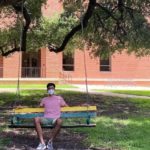
Sai Sagireddy is an incoming freshman at Baylor University. He is part of Baylor’s University Scholars Cohort Class of 2024 with concentrations in biology/biochemistry, Spanish, and medical humanities (pre-med). He is passionate about research, global health, healthcare management, health equity & health accessibility. In his free time, he enjoys the company of others, settling down a good book, exercising, hiking, traveling, and exploring the outdoors.
The Act Locally Waco blog publishes posts with a connection to these aspirations for Waco. If you are interested in writing for the Act Locally Waco Blog, please email [email protected] for more information.
By Lindsey Breunig-Rodriguez
Recently I have been thinking about the “Wild West” — a time when there was a lot of discovery and a lot of unknown. I must say, it somewhat feels like we are in a modern-day Wild West. I can only imagine how difficult it was to stay hydrated. Someone probably shared a water canteen and planned travels according to where the next water source would be.

Today we do the same when we camp, go hiking or walking, or are outside for an extended time. To avoid dehydration, we must actively think about drinking more water, and even more so in these hot summer months.
Thankfully, we do not have to solely rely on water; fruits and vegetables also provide us with water. This month we are highlighting a vegetable which consist of 95% water, making it a great source for extra hydration and is even named for its season. Introducing summer squash!
Nutrition:
Per USDA dietary guidelines it is recommended we consume 3 Cups of vegetables daily. Vegetables may be fresh, canned, frozen, or dried, and may be whole, cut-up, or pureed. It all counts!
Summer squash is a great source of vitamin C, which keeps our immune system strong and helps our bodies heal quickly. Additionally, summer squash is fat free, saturated-fat free, sodium free, cholesterol free, and low in calories (around 20 calories in 1 cup). It is not recommended to peel summer squash because most all the vitamins and minerals are found in the skin.
Shopping, Storage, and Preparation:
There are two types of squash: summer and winter. Today we are focusing on summer squash. There are many varieties of squash, some names you will see are: patty pan, yellow crookneck, yellow straightneck, chayotes, and zucchini. For all squash varieties, choose firm, glossy, small to medium-sized squash. Avoid squash that is soft, moldy, or sunken in spots. Though usable, larger squash tend to be less flavorful and tougher.
Right before using, wash squash by rubbing the skin under cool running water. Refrigerate summer squash for up to one week or freeze and use within three months. If freezing, cut it into pieces and blanch (placing vegetables in boiling water for a short time and then placing in freezing water.). For more instructions, read here.
Enjoy:
Due to its mild flavor summer squash can be prepared multiple ways. It is important, however, to remember that seasonings or other ingredients added to squash will change the nutritional value. Below are some ways to enjoy it:
Roast — Cut squash in slices and drizzle with olive oil and low‐sodium seasoning before placing on a baking sheet. Cook 10-15 minutes or until tender.
Grate — Add raw, grated squash to green salads, muffins, or cookies. Use a vegetable peeler to make ribbons in place of pasta noodles.
Grill — Pair squash with tomatoes, onions, mushrooms, peppers, or fruit.
Raw — Enjoy in salads or dipped in hummus or a low-fat dip.
Sauté — Heat pan to high, add oil to coat the pan and add sliced squash. Sauté until lightly brown, about 3‐5 minutes, or tender. Use as side dish or add to dishes like stir fry or pasta.
Check out these other tasty recipes too: Italian Spinach and Zucchini Meatballs or Baked Zucchini Sticks
See below different ways to cut and prepare zucchini – thank you to Montana State University Extension for the graphic:
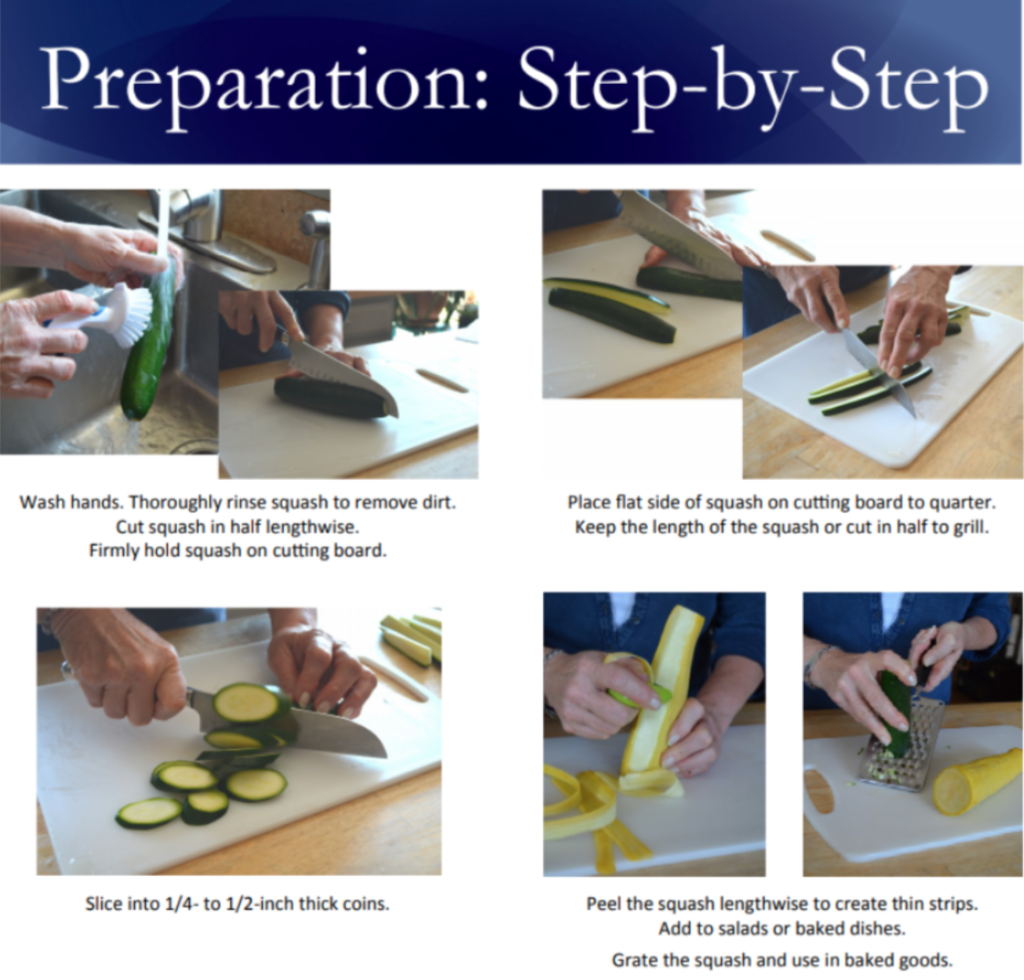
Texas A&M AgriLife Extension
Due to the continued spread of COVID-19 and the challenges it poses to communities across Texas, Texas A&M AgriLife Extension and many others continue to practice public health recommendations. Whether we are communicating online or face-to-face know that program content will always be research-backed to help individuals navigate decisions for themselves and their families. For information on resources, ideas, and programs for yourself and family visit Texas A&M AgriLife’s HUB.
USDA is an equal opportunity provider and employer. This material was funded by USDA’s Supplemental Nutrition Assistance Program — SNAP. To learn more about the Supplemental Nutrition Assistance Program (SNAP) or to apply for benefits, visit www.yourtexasbenefits.com

Lindsey Breunig-Rodriguez is an Extension Agent for the Better Living for Texans program with the Texas A&M AgriLife Extension Service. She is originally from Grapevine but now calls Waco home. A graduate from Baylor University, she loves to venture out to Cameron Park, visit the local Farmers Market, and try out the awesome eateries in Waco. If you see her and hear a loud bark, that’s her pup Lucy Ann just saying hello.
The Act Locally Waco blog publishes posts with a connection to these aspirations for Waco. If you are interested in writing for the Act Locally Waco Blog, please email [email protected] for more information.
(From Waco’s COVID-19 Community Newsletter)
As the Central Texas community participates in demonstrations and protests against the killing of George Floyd and continued racial injustice and inequity, community leaders encourage health and safety precautions for group gatherings. Dr. Iliana Neumann of Family Health Center shares a few health tips for community members participating in protests and demonstrations.
We encourage organizers to provide masks and hand sanitizer to the extent they can and to model the use of such as well as practice physical distancing as much as possible.
- Assembling does increase your risk of contracting COVID-19, but there are things you can do to lessen this risk.
- Gather outside rather than inside.
- Wear a cloth face covering.
- Physically distance as much as possible.
- Do not share signs or markers with anyone who is not a member of your household.
- Take hand sanitizer and gloves with you. Use hand sanitizer often.
- If distributing materials, encourage folks to take a picture of the materials with their phone instead of handing off paper or other items.
- Bring water and drink it often.
- Wear sunscreen.
- Reduce respiratory droplets by focusing on signs/posters and making noise with music, drums, etc. rather than loud talking.
- Carry identification and a list of emergency contacts.
- Go with a buddy and stay closer to them rather than new contacts.
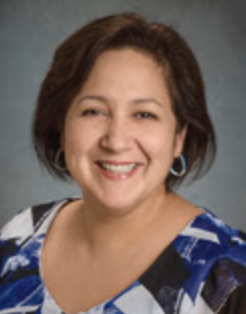
Dr. Iliana Neumann is a family medicine specialist. She graduated with honors from East Carolina University School Of Medicine in 2009. She is a faculty physician with Waco’s Family Health Center.
Press Release – The Waco-McLennan County Public Health District, Ascension Providence, Baylor Scott & White, and the Family Health Center have formed the McLennan County Leadership Response Team to work and plan together on a local response to reports on the COVID-19 outbreak in the country. Meeting weekly as a group, we are actively monitoring patients for risk factors and working to ensure our local health care system is prepared to respond to the situation as it unfolds.
There has been a lot of information in the news about COVID-19. If you are healthy, your risk is relatively low and recovery is high. The good news is that the same steps you can take to stay healthy during the flu season will protect you from many viruses, including the flu and COVID-19. The Response Team has prepared a list of important facts to help people understand the current situation. This is a rapidly evolving situation and the Response Team will provide updated information as it becomes available.
Risk
- There are NO diagnosed COVID-19 cases in McLennan County.
- At this time, if you have not traveled to an effected area or have not had contact with someone with COVID-19, your risk is low. Any respiratory symptoms you might have are more likely to be flu or another respiratory illness.
- Most cases of COVID-19 are not severe. People with a greater risk of developing serious symptoms are Older adults; People with chronic conditions; and People with compromised immune systems.
Symptoms
- Fever
- Cough
- Difficulty Breathing
Facemasks
- Facemasks are NOT recommended for people who are well. The use of facemasks are crucial for health care workers and other people who are taking care of someone infected with COVID-19 in close settings (at home or in a health care facility).
- You should only wear a facemask if a healthcare professional recommends it.
Protection
There is currently no vaccine to prevent COVID-19 infection. The best way to prevent infection is to avoid being exposed to this virus. The Waco-McLennan County Public Health District (PHD) encourages everyone to follow preventive actions to help prevent the spread of respiratory viruses, including:
- Wash your hands often with soap and water for at least 20 seconds. If soap and water are not available, use an alcohol-based hand sanitizer with 60%-95% alcohol.
- Avoid touching your eyes, nose, and mouth with unwashed hands.
- Avoid close contact with people who are sick.
- Stay home when you are sick.
- Cover your cough or sneeze with a tissue, then throw the tissue in a lined trash can.
- Clean and disinfect frequently touched objects and surfaces with regular household products.
Isolation and Quarantine
- Your healthcare provider or the Public Health District may ask you to stay at home in order to slow the spread of the virus. Please follow the instructions given to you.
Questions
People with questions can call the Public Health Information line at 254-750-1890 which is available Monday through Friday from 8am – 5pm.
Information
This is an rapidly evolving situation and Public Health District will provide updated information as it becomes available. The most trustworthy sources for information are:
- Waco-McLennan County Public Health District;
- Texas Department of State Health Services;
- Centers for Disease Control and Prevention; and
- World Health Organization.
By Lindsey Breunig
In 2020, the Better Living for Texans posts will continue, and we are excited to announce that monthly posts will start focusing on a seasonal fruit or vegetable. Material shared will include the nutritional value/benefits, how to select and store, cook and use, and other fun facts regarding the chosen fruit or vegetable! Have a request? Feel free to share and let us know!
Per USDA dietary guidelines it is recommended we consume 1 – 2 Cups of fruit daily. Fruit may be fresh, canned, frozen, or dried, and may be whole, cut-up, or pureed, it all counts! In general 1 cup of fruit or 100% fruit juice, or ½ cup of dried fruit can be considered as 1 cup from the Fruit Group. Like vegetables, we want a variety of color on our plate and in our diet, one way to vary your plate is by choosing fruits that are in season! As we transition into the winter months one may traditionally label winter colors as “darker” and “warmer,” but today’s highlighted fruit is not the case! Winter season is “when you’ll find the bright greens, eye-popping yellows, and oh-so-lively oranges.” Let’s bring out the bright colors and talk about citrus fruits!
Citrus includes but is not limited to oranges. Other types of citrus fruits are lemons, limes, mandarins (tangerines), grapefruit, and kumquats. (source) When shopping for citrus look for a peel that is smooth in texture versus a thicker bumpy peel. Avoid citrus that has soft or mushy spots. Citrus fruits come from a tree and do not continue to ripen once they are picked. For juicy citrus choose a heavier a fruit, and for good flavor take a whiff and know a sweet fragrance often means good flavor. For continued best quality of the fruit, store in the refrigerator’s crisping drawer. Citrus will keep in the fridge for several weeks compared to a few days to a week if stored on the counter. (Source). Citrus fruits are high in vitamin C and folate. Vitamin C is important for growth and repair of all body tissues, helps heal cuts and wounds, and keeps teeth and gums healthy. When it comes to citrus fruits there are a range of options available.
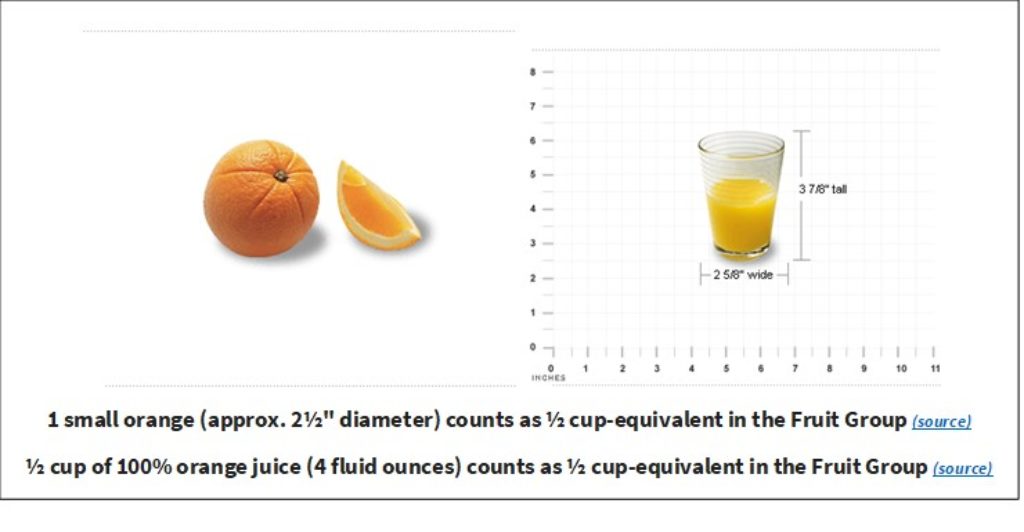
Orange juice is a common staple for many, but one must use caution to ensure it is not the only source of fruit. Juice should make up half or less of total recommended fruit or vegetable intake. Whole or cut-up fruit will provide dietary fiber and reduce sugar intake when compared to juice. Think about how many oranges it takes to make a cup of juice – about 3 oranges! Though naturally occurring, the sugar from one orange compared to a cup of juice adds up quick! If you don’t mind the flavor, try cutting your juice with water to reduce sugar. Additionally, when selecting juice, read the nutritional label on the back to verify there are 0g of Added Sugars.
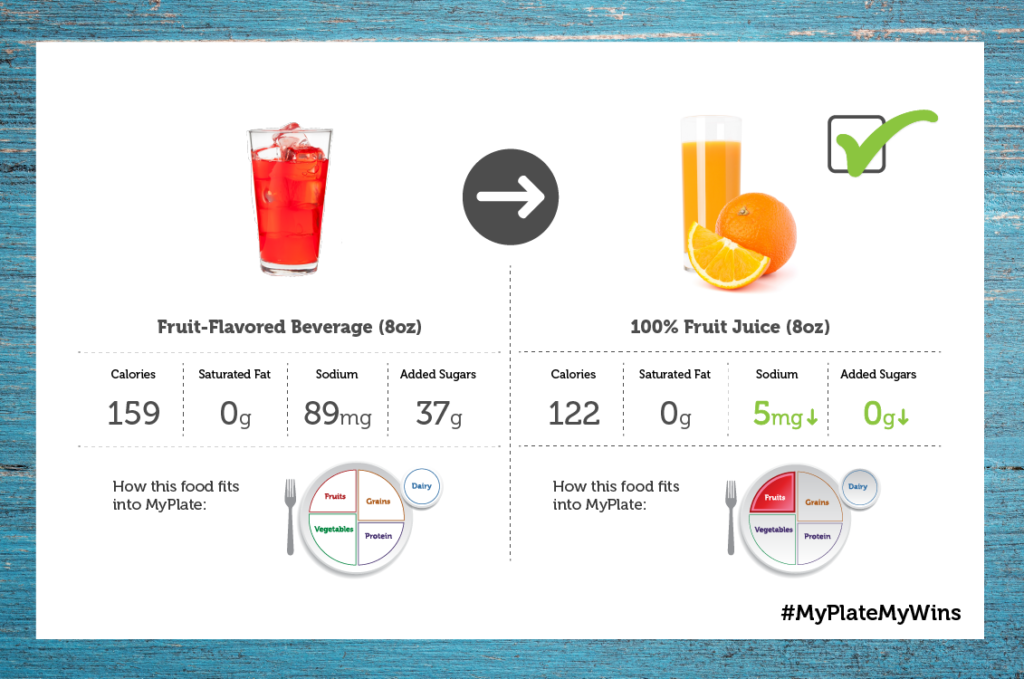
Precut fruit can be convenient and a great snack option, but often has a higher price tag. Luckily during citrus season mandarin (tangerine) oranges are often on sale and make for a great snack. Trying to find the best deal? Always compare the unit price to see the best deal. See the example below, what would you choose?

Inspired to add more citrus into your winter cooking? Check out some of these great recipes!
- Orange and Ginger Salmon
- Grapefruit Salad and Vinaigrette
- Asparagus, Mandarin Orange, Chicken and Rice

Lindsey Breunig is a graduate of Baylor University and currently works as the Better Living for Texans Educator for the Texas A&M AgriLife Extension Service. She is originally from Grapevine, TX and now calls Waco home. Here in Waco she loves to venture out to Cameron Park, visit the local Farmers Market, and try out the awesome eateries in Waco. If you see her and hear a loud bark, that’s her pup Lucy just saying hello.
USDA is an equal opportunity provider and employer. This material was funded by USDA’s Supplemental Nutrition Assistance Program — SNAP. To learn more about the Supplemental Nutrition Assistance Program (SNAP) or to apply for benefits, visit www.yourtexasbenefits.com
The Act Locally Waco blog publishes posts with a connection to these aspirations for Waco. If you are interested in writing for the Act Locally Waco Blog, please email [email protected] for more information.
Top 10 “Most Opened” Blog Posts of 2019: # 5
By Ellie Triplett
If you avoid gluten for any reason, eating out can be a challenge. If you’ve been doing it for any amount of time, you’re probably an old pro at the basics of avoidance when it comes to regular menus. But what about when you want something as classic as a cheeseburger? Where do you go for your macaroni and cheese cravings? Where can you find gluten-free pancakes? Or, the golden chalice of gluten-free eating, where can you go for pastries? Never fear, my friends, you are in luck. I am here to tell you that you are living in a town with a growing culinary culture, with restaurants that provide an impressive array of allergen friendly dining options. What follows is a very basic, non-comprehensive list of where to find your fill of sans-gluten treats in good ol’ Wacotown.
It seems logical to start with breakfast. If you are looking for pancakes, Café Cappuccino (with three locations at 100 N. 6th St., 1101 Richland Dr., and 903 N. Hewitt Dr.) is known for its amazing, plate sized pancakes, and now they come in gluten-free! I have personally ordered and enjoyed them.
Uptown features wonderful vegan and gluten- free waffles at Luna Juice Bar (1516 Austin Ave.). In carrot, matcha, and strawberry, the waffles are made with oat flour, gluten-free flour, or coconut flour and topped with coconut whipped cream, and are DELICIOUS. Pair them with a smoothie, or a cold pressed juice and you’ve got a perfect breakfast. Luna Juice also has a full menu of delicious salads, soups, and wraps, if you need a quick lunch later in the day.
Down the street at Harvest on 25th (112 N. 25th St.) you can continue your breakfasting or slide right into brunch with gluten free muffins, pancakes, or avocado toast. They offer ways to make their entire menu gluten-free and also offer gluten- free pizzas.
Since we’ve moved on to lunch, and specifically pizza, it is worth mentioning that Poppa Rollos (a long time local favorite at 703 N. Valley Mills) offers a good gluten-free version, and both Slow Rise Slice House (7608 Woodway Dr.), and 900 Degrees Pizzeria (315 S. University Parks) have cauliflower crusts which are keto friendly as well as being gluten-free.
If you’re craving a hamburger, look no further than Tom’s Burgers (6818 Sanger Ave.) It is a mom and pop burger joint that has just recently been brought to my attention for their gluten-free buns.
A newer option with gluten-free buns and bread is Revival East Side Eatery (704 Elm Ave.). They have a full menu, including soups and salads, so you’re sure to find something for everyone.
If you’re looking for the kings of comfort food (in my opinion), macaroni and cheese and grilled cheese sandwiches, look no further than The Mac House (3428 Franklin Ave.). Their artisan sandwiches and macaroni creations are amazing, and worth every penny and every minute you’ll spend waiting (it’s a bit, y’all, but worth it!).
Which leads me to my favorite way to splurge on gluten-free food; the pastries. Fabled Bookshop downtown (215 S. 4th St.) has gluten free lemon poppy seed cake as a part of their newly opened café, alongside literary themed drinks and other snacks. However, Baked Bliss (1114 N. 15th St.) is truly the sweet spot for sweets (see what I did there?) with cinnamon rolls, cranberry orange scones, brownies, chocolate chip cookies, blueberry muffins, and bacon cheddar scones (if you’re feeling the savory side of things) all offered gluten-free daily. You can pre order their gluten-free bread, which they bake on Wednesdays in a completely gluten-free kitchen, on Tuesday mornings. They also have gluten-free cakes, cupcakes, lemon shortbread, and pecan shortbread cookies, all of which can be made ahead of time for special events.
Phew! It’s a lot! A couple of things to note as we wrap up. Firstly, I am not a food blogger, or really any type of blogger. In many of these cases, I have eaten and enjoyed the food, but this is not true across the board. As a result, I did not attempt to describe in too much detail the experience of eating the food, so as to be fair. Secondly, this is by no means a comprehensive list. If your restaurant, or your favorite restaurant was left off the list, it is in no way meant as a slight. I polled my friends, asked for help, and sent out a few cursory messages asking for clarification on menu items. The result is this post. If I made a grievous error, leave us a comment! Share your knowledge! Thirdly, it is important to keep in mind that there are no certified gluten-free kitchens on this list. Most things will experience some level of cross contamination, and you are, as always, advised to check with your servers and express your level of allergy, and make an informed decision for yourself.
Happy (and safe!) eating, friends!
A couple of other resources…
- Gluten Free Waco website and Facebook page.
- “Find me Gluten Free” app

Ellie Triplett is a book lover, weaver, former bee keeper, and enneagram four. She lives and works (and eats) in Waco alongside her spouse and their three children.
The Act Locally Waco blog publishes posts with a connection to these aspirations for Waco. If you are interested in writing for the Act Locally Waco Blog, please email [email protected] for more information.
By Carlos Hinojosa
Centering Pregnancy is a fairly new concept that seeks to take prenatal care out of the exam room and into a comfortable and communal setting. It blends regular prenatal visits together with support groups of expecting mothers with similar due dates. Expectant mothers meet for their monthly check-ups, where physicians and nurses facilitate sessions and answer questions that the mothers and their partners have about different aspects of pregnancy. The goals of Centering Pregnancy are to increase the amount of time providers can spend with their patients, improve birth outcomes, help patients build a community of support, and impart a level of knowledge to the patients so they can best care for themselves.

Karla, one of Family Health Center’s patients, recently went through the program herself. Karla has been a patient of Family Health Center since she was born. Her care at FHC actually goes back even further. Her mother was an FHC patient and received her prenatal care here as well, but didn’t experience anything quite like Centering Pregnancy.
When Karla learned she was pregnant, she and her husband were very excited – and a little nervous. There was so much to learn, and neither Karla nor Juan knew quite what to expect. Karla’s doctor talked to her about Family Health Center’s Centering Pregnancy program, and Karla’s mother encouraged her to go. Karla was glad she did. “It was an open and fun way to learn about what was going on inside of me.”
Each meeting, participants gathered in the Centering room at FHC, and one by one, mothers-to -be stepped back into a private area to have their vitals checked and measurements taken to track their progress. After everyone had seen the doctors, the class sessions began. Resources books were issued, and classes featured different activities corresponding to what was happening at that stage of pregnancy. Classes also allowed ample time for questions. “I always had questions, but Juan had even more questions than I did,” Karla said. “You could be sure that if you had a question and were afraid to ask, someone else would ask it.”
The group sessions used the activities to help foster conversation, and those conversations helped everyone get to know each other. Members of each class are encouraged to keep in contact with one another after the classes were over, and Karla has maintained a friendship with one of the members of her group. “It’s nice to know other people who are going through the same things I am, and it helps to be able to talk to someone else.”

When the time came for Karla to deliver, she felt prepared and confident. She didn’t feel overly nervous, and she thanks the team at FHC for preparing her so well. “Centering Pregnancy taught me all of the things I needed to know before my daughter arrived.”
Centering Pregnancy is just another tool Family Health Center is using to improve the health of our community and make a difference for the families we serve. When asked her thoughts on the program as a whole, Karla said, “It was so great that I tell all my friends who are pregnant to go! The next time I have a baby, I plan to go again.”

Carlos Hinojosa serves as Development Director for Family Health Center in Waco. He holds a bachelor’s and master’s degree from University of Mary Hardin-Baylor and has been living in Waco for 18 years. When not at work, Carlos loves to spend time with his wife and two sons taking walks, making up silly games, and perfecting the art of dad jokes.
The Act Locally Waco blog publishes posts with a connection to these aspirations for Waco. If you are interested in writing for the Act Locally Waco Blog, please email [email protected] for more information.
By Rae Jefferson
May is National Mental Health Month, which means there’s no better time to talk about the way mental health is approached by our community. In 2018, Family Health Center (FHC) provided more than $2.2 million in behavioral health services to patients in McLennan and Bell counties. It’s important to note that majority of the patients at FHC qualify as low-income and receive services through Medicaid, Medicare, or out-of-pocket payments. We strive to provide full-scope, compassionate care in the form of medical, dental, and behavioral health services.
Although participation in our behavioral health services is increasing each year as patients learn about our programs and their own mental and emotional needs, it is still one of the lesser-utilized programs at FHC. There are a number of reasons for this, including the fact that not every patient needs behavioral health services. But FHC is also aware that, in our quest to offer high-quality behavioral health care to primarily low-income populations in Waco, we’re up against challenges like stigma, financial limitations, and patients who don’t know how to identify their own mental and emotional needs.
The National Alliance on Mental Illness reports one in five American adults will experience mental illness in a given year. The definition of mental illness is sprawling and ranges from mild cases of depression or anxiety to debilitating battles with post-traumatic stress disorder or schizophrenia. Despite the prevalence of mental illness, studies show that individuals from low-income households, communities of color, or religious environments are less likely to seek medical care for mental health concerns. Furthermore, people of color are at higher risk of mental and emotional distress, with African Americans alone being 20 percent more likely to experience major depression, posttraumatic stress disorder, and suicide. The majority of FHC patients fall into one or more of these categories, often making it a challenge to treat patients who feel they can’t seek help.
FHC takes several approaches to providing accessible behavioral healthcare. We accept patients with and without insurance and can charge on an income-based sliding scale. Of all the barriers to mental health care, we strive to make finances one of the easiest to conquer.
Integrated Behavioral Health (IBH) is FHC’s way of practicing healthcare that allows patients attending a regular doctor’s appointment to see a behavioral health specialist, called an Integrated Health Manager (IHM), in the same visit. These Licensed Clinical Social Workers are on-call to provide mental and emotional support to patients while also determining diagnoses and treatment recommendations to the physician. This process eliminates the need for making follow-up diagnostic appointments or delaying treatment for the patient.
FHC provides traditional counseling through our Family Counseling and Children’s Services Program. We also organize support groups for patients who are pregnant, nursing, or fostering a child. Although these groups are not immediately related to traditional behavioral health services, they often provide emotional support in a group setting that facilitates community-building and leads to a healthier emotional life.
Although we’re already working hard to address mental health needs among low-income Wacoans, we’re always looking for ways to improve these efforts by expanding our programs and partnerships. This summer, the behavioral health team is launching a program in which patients can receive counseling services via in-home visits. This will help address patients’ transportations issues and allow them to explore mental health concerns in a familiar environment.
FHC is one of many organizations in town stepping up to the challenge of providing mental health services to low-income individuals in Waco. We hope our work and the efforts of others can push the needle in such a way that stigma and barriers, both real and perceived, can begin to fall away.

Rae Jefferson is a creative, Netflix binger, and marketing professional, in that order. Originally from Houston, she stuck around Waco after graduating from Baylor University with a B.A. in Journalism, PR, & New Media and a minor in Film & Digital Media. Now she’s the Communications Director at Family Health Center, where she gets to spend each day serving Waco. When she’s not working, find her at home snuggled up with her dog-daughter, Charlie, watching “The Office” for the hundredth time.
The Act Locally Waco blog publishes posts with a connection to these aspirations for Waco. If you are interested in writing for the Act Locally Waco Blog, please email a[email protected]for more information.
By Khristian Howard
If you have been around Waco for a while, you may recall “Move East Waco,” the fitness series that got East Waco up and active two summers ago. We are thrilled to announce that exciting six-week campaign for health education, fitness, and community will be back this summer to continue the impact it began in 2017. Packed with incentives, fun, and most importantly, FREE workout sessions, “Move East Waco 2019” will give you the motivation you need to begin or continue your fitness journey. This year’s series will begin on May 16th at 6:30 p.m. at Oscar DuCongé Park (1504 J.J. Flewellen) and will feature some new and familiar faces to give previews of the workouts and health lectures that will follow in the subsequent six weeks.
Success During Summer ’17 & Hopes for this Year

Move East Waco had its debut in the summer of 2017, and immediately proved to be a hit within the community. Cuevas Peacock, community organizer and co-creator of Move East Waco, shared that in 2017 they saw over 100 people attend the kickoff, and [an] average 15 people at the various workouts. This year, Cuevas and the team hope to double the participation numbers, and to implement some new tracking measures that will provide a more comprehensive report of the program’s impact. Cuevas has garnered support from several East Waco community members, many of whom were key players in the success of Move East Waco ’17. These team members include, Tara Briscoe, Victoria Calhoun, Vivian Vonner, Ashley Royal, Sandra Dorsey-Butler, and Van Davis, to name a few. Some of the main organizations represented are Grassroots Community Development, Live Well Waco, Baylor Health & Wellness, and more.
To ensure that the goal of doubling participation is met, the team has secured various incentive donations from places like, Gold’s Gym, Refit Waco, Orange Theory, Jamba Juice, Da Shack Farmer’s Market, and more. Additionally, participants can expect a wide variety of workouts and demonstrations ranging from Zumba, line dance, and hip-hop aerobics to cooking demos, healthy food budgeting classes, and stress relief exercises.
As mentioned above, this summer will mark the second installment of Move East Waco. With the help of health and fitness instructors and local businesses providing services and incentives, the program proved to be a huge success in its first installment. Still, you may be wondering, why do a health and fitness series…and why in East Waco? Cuevas Peacock gave us a glimpse into the motivation behind Move East Waco. He shared some troubling statistics about health in East Waco.
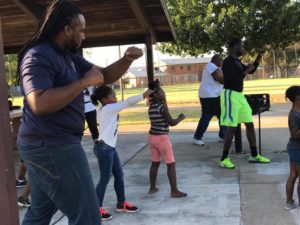
He stated, “Throughout our nation, 12% of residents report being in poor health, in Waco the number rises to 13.2%; however, in East Waco, the number grows even more to 18%. Nationally, 29% of residents are obese, but in East Waco, the number grows to a staggering 45%.” Move East Waco is a solution that Cuevas believes will be a significant factor in decreasing these numbers. “It is our belief that by increasing the amount of physical activity among the residents of East Waco we can begin to lower the high obesity rate and improve the community’s overall health.” Ultimately, Cuevas summarized the goals of the program as a way to “[demonstrate] various ways for our community to get up and get moving, along with providing access to vendors that could address various health issues…[along] with the hope to Move East Waco towards adopting a healthier lifestyle.”
We Want to See You There!
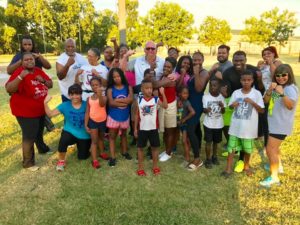
This year’s kickoff event will begin at 6:30 p.m. on Thursday, May 16th, at Oscar DuCongé Park Park in East Waco (1504 J.J. Flewellen), next door to G. W. Carver Middle School. There you will be able to learn easy fitness practices that can be practiced at home. Additionally, this kickoff will give you a preview of each instructor who will be heading up classes throughout the rest of the program. Classes will be held on Tuesdays and Thursdays at 6:30 p.m. from May 21st to June 27th. Do not hesitate to take advantage of free access to health and fitness materials provided by local professionals – and access to great giveaways that can assist you in living a healthier, fuller lifestyle. Join us as we “Move East Waco” closer to maximum wellbeing!
Click here for “Move East Waco 2019 Schedule

Khristian Howard is an Atlanta native and a recent graduate of Georgia State University where she earned a Bachelor’s Degree in Social Work. She has a passion for empowering communities through service, and seeks to connect advocacy to creativity. Currently, she is serving as the AmeriCorps VISTA for Texas Hunger Initiative Waco, where her work focuses on fostering collective impact to improve health and eating habits in East Waco. When she is not working, you may find her sharpening her culinary skills or exploring new poetic and artistic pathways.
The Act Locally Waco blog publishes posts with a connection to these aspirations for Waco. If you are interested in writing for the Act Locally Waco Blog, please email [email protected] for more information.
By Glenn Robinson
When you think of patient care, doctors and nurses are usually at the forefront of everyone’s mind. However, hospitals are increasingly utilizing supplemental programs in addition to the excellent care provided by their clinical staff to fulfill their mission of caring for “the whole patient.”
This month, we take a look at three lesser-known roles in health care that are just as vital to the patient experience and road to recovery as that of a physician or nurse.
Patient Navigators
If you’re going on a long journey to somewhere you’ve never been before, the best bet to get to your destination is being aided by navigation. The care process for a terminal disease or chronic illness is often described as a journey – physical, emotional, and spiritual – so one of the ways many health systems are making the road to survivorship easier is by offering patient navigation.
A patient navigator is a partner for patients and families from the time of the initial diagnosis and throughout their journey – wherever that may lead. A patient navigator strives to help patients make decisions and find their way through the complexities of the healthcare system so they can focus on recovery.
Navigators connect patients with resources and information to help them better understand their diagnosis and treatment options. They can also help remove barriers, whether they be financial or practical – like transportation to and from appointments.
Additionally, patient navigators serve as personal advocates to help ensure patients are receiving high quality care and have all the answers they need… even if it means challenging the status quo.
Another critical job of a patient navigator is to provide emotional support. Patients sometimes have a hard time expressing their fears and sadness even to their closest loved ones, so a navigator can be that listening ear.
On the road to survivorship, to some patients, the help and support navigators provide may be as important as the caregivers delivering the treatment.
Community Health Workers
Community health workers have emerged as an effective strategy in engaging patients and caregivers in lowering costs for healthcare’s “frequent flyers” – patients who often visit emergency rooms and fill hospital beds.
Community health workers have been part of healthcare worldwide for decades. They generally are not doctors or nurses, and often are recruited directly from the communities they serve. Their purpose is to help individuals navigate the healthcare system, manage chronic illnesses more effectively, and access preventive care.
They also help patients tackle important health-related issues such as food and housing insecurity. Community health workers often serve people in impoverished communities who lack access to quality healthcare, lack the means to pay for healthcare, do not speak English fluently, or have cultural beliefs, values, and behaviors that differ from those the traditional U.S. healthcare system is geared towards.
New research suggests these workers may contribute to fewer days in the hospital for some patients. Patients with help from a community health worker were nearly twice as likely to report receiving high-quality primary care and spent fewer total days in the hospital.
Recognizing the value of these individuals, the Texas Department of State Health Services has a community health worker certification program to develop these dedicated individuals’ communication and navigation skills, as well as their knowledge of available community resources.
Though typically not clinicians or administrators, community health workers are playing an increasingly important role in healthcare quality and cost.
Volunteers
Often known as candy stripers in the past, today, hospital volunteers are a diverse group of men and women of all ages who perform a wide range of functions.
Volunteers are vital members of the community and the hospital team who share their time, talents, and passion for helping others, while either directly or indirectly making a difference in the lives of patients and families.
There are many different roles for hospital volunteers. Some oversee the hospital information desk and provide directions and a warm smile to patients and visitors. Others deliver flowers and packages to patients, run the gift shop, or perform a full range of back-office administrative tasks so other staff can keep their focus narrowed in on patient needs.
Many hospitals also have special volunteer programs. For example, pairing former patients who have successfully overcome a serious condition, such as heart disease or cancer, with patients who are now on that same journey. Or even more innovative programs like volunteers who share their musical or artistic talents with patients as a form of therapy. There are even animal-assisted therapy volunteer programs at some hospitals in which four-legged volunteers join their two-legged team members to bring smiles to patients’ faces.
Programs like these have been shown to raise the spirits of patients and can contribute to a better patient experience. But volunteers also benefit. Research has demonstrated that volunteers are often healthier, happier people.
Hospital volunteers truly create a win-win-win situation – for themselves, for patients, and for the hospital.

Glenn Robinson is the President of Baylor Scott & White Medical Center – Hillcrest. He has over 30 years of experience in hospital and health care management, and currently serves on several Boards associated with the Texas Hospital Association and the American Hospital Association. In addition, Glenn is Past-Chair and an active member of the Greater Waco Chamber of Commerce, and serves on the Prosper Waco Board.
The Act Locally Waco blog publishes posts with a connection to these aspirations for Waco. If you are interested in writing for the Act Locally Waco Blog, please email [email protected] for more information.

